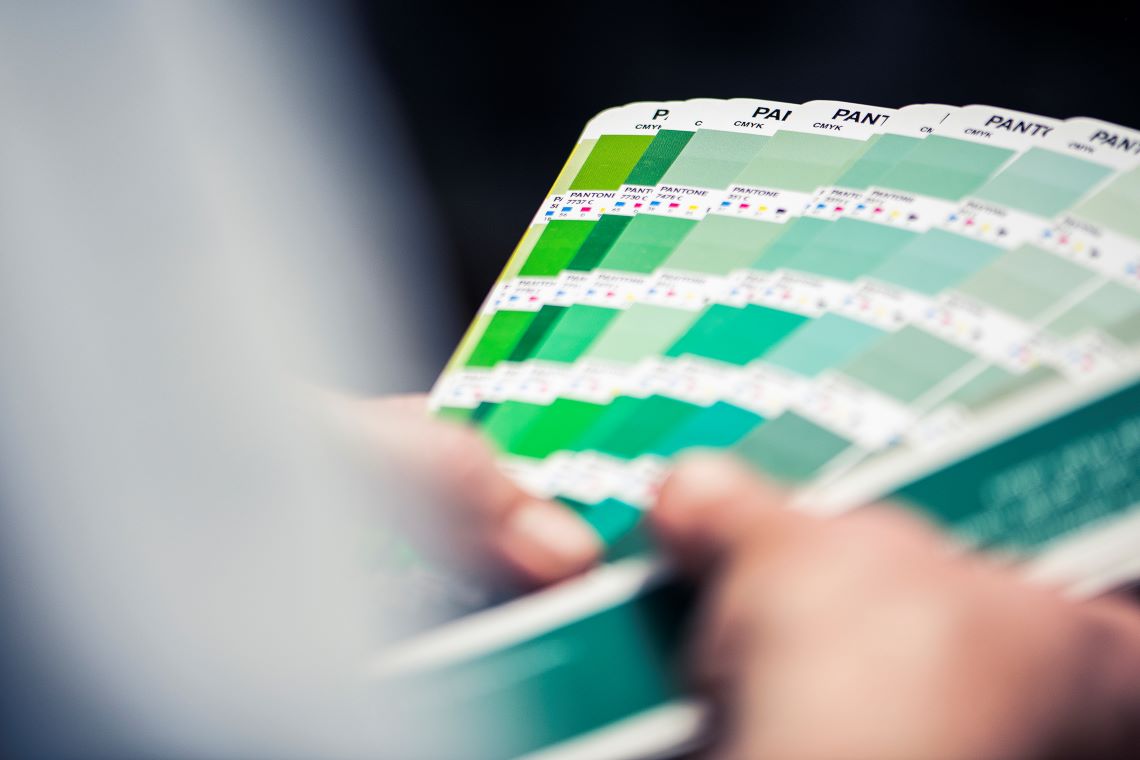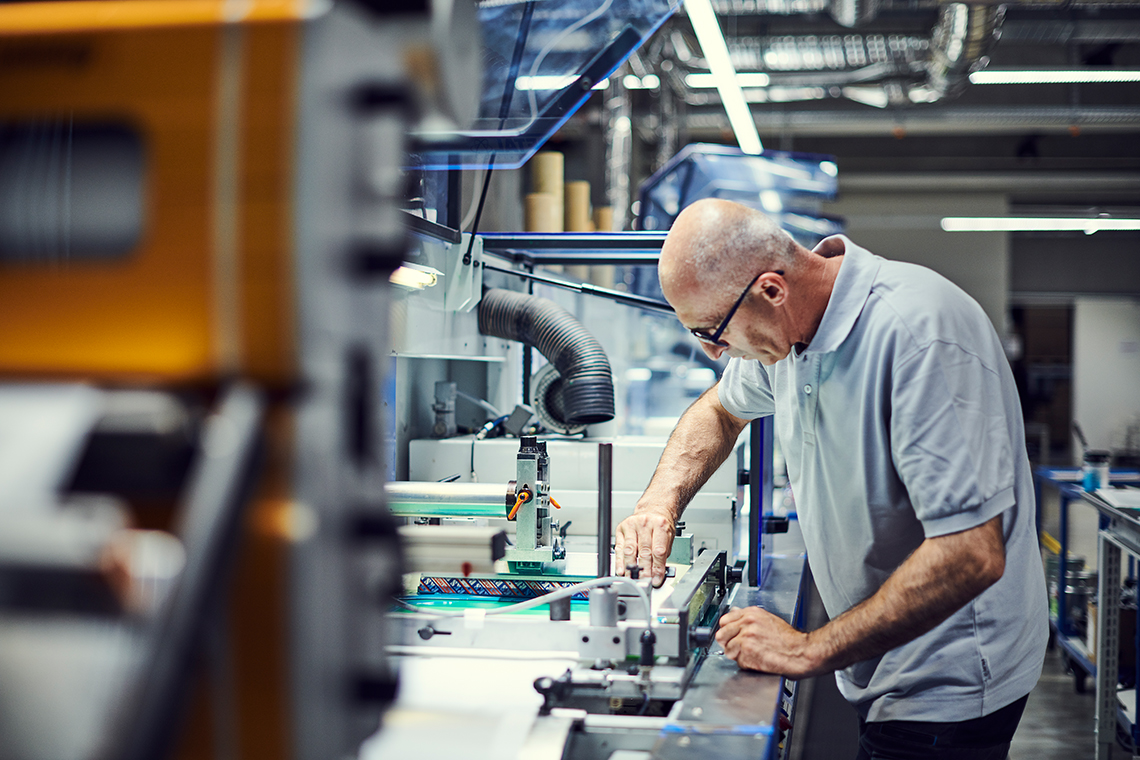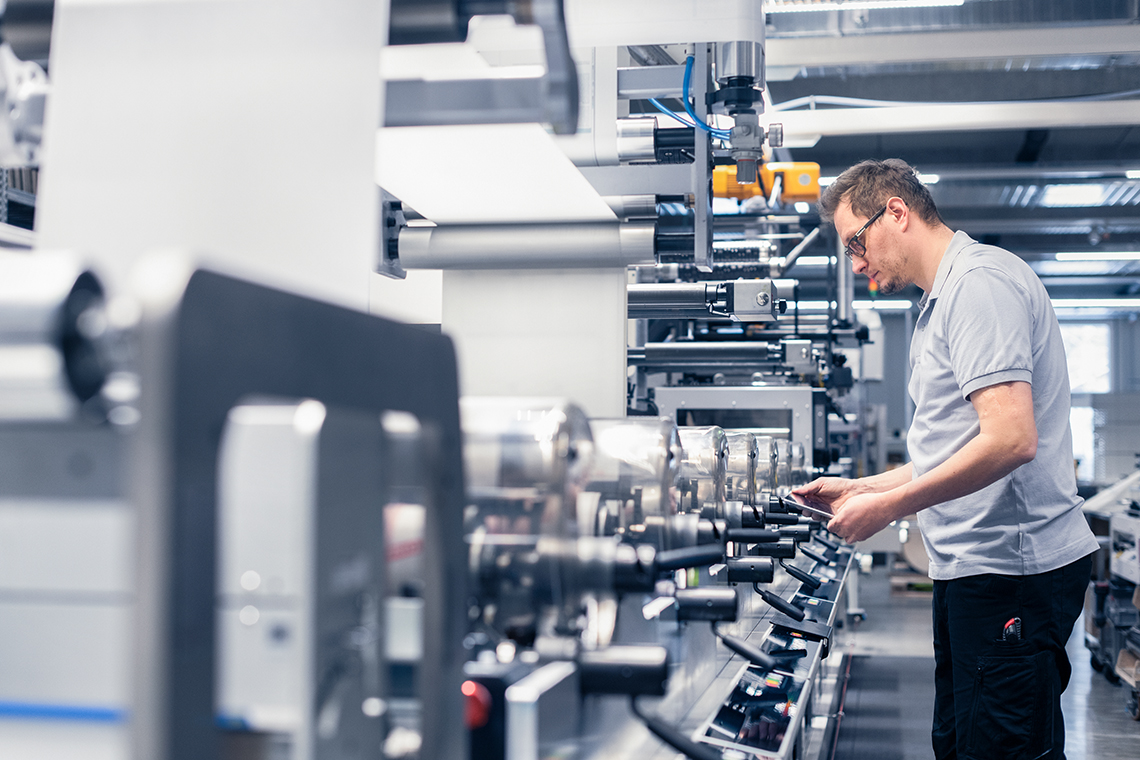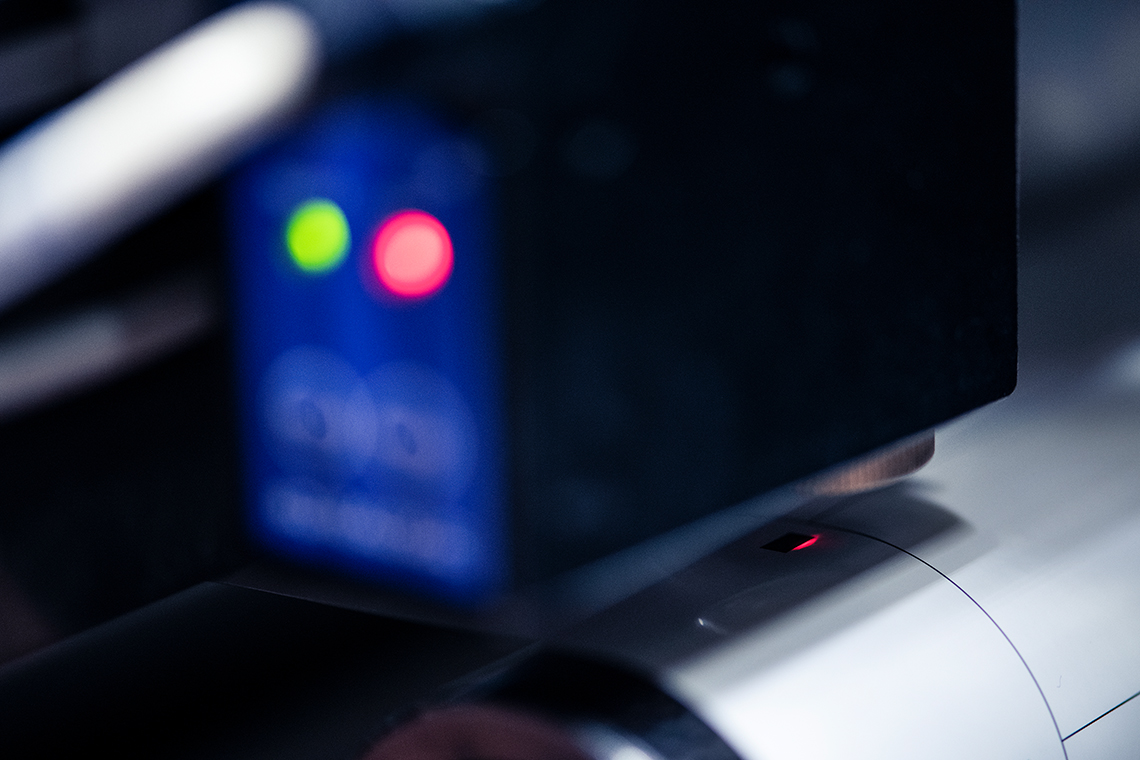BRILLIANT AND DURABLE
Press
Press: brilliant and durable
Our pressroom includes both analog and digital printing methods. Our goal is to be technologically equipped in the best possible way to be able to implement the wishes and requirements of our technical industrial customers. For that we rely on different printing methods to be able to integrate their respective strength optimally in our solution approaches.
Digital printing
Compared to conventional printing, digital printing gains increasing importance, because it offers flexibility, high color brilliance and increasing resistance. This way the digital manufacturing process allows for short-termed motif changes, small sample runs or sorts in flexible runs. The supply of different markets often requires individual versions and small(est) print runs. These can be realized in digital printing much more price appealing because no printing plates, clichés or screens are necessary.
Also the printing quality is worth seeing: metallic effects and an excellent color specter – our digital printing systems cover up to 97% of PANTONE© palette. Here ElectroInc-Systems by HP as well as UV inkjet systems are available, which will be chosen according to the needed project requirements. A distinction is made between short-term applications indoors and up to long-term labeling solutions outdoors.
Your benefits
Changes at short notice
In digital printing the changes in motif can be made until shortly before the actual production deadline, because no printing forms have to be manufactured or modified. As a template serves just a digital printing template. This way the digital printing can realize short term pre-series and test samples for test markets in any print runs and the pass- and set-up times will be additionally shortened. Due to the digital printing template the changes of sorts can be directly implemented in digital printing. In addition, there are low set-up costs because the physical printing plates are not required.
Individualization
Personalization, regionalization and seasonalization lead to dwindling print runs and to the increasing degree of individualization. In times of rapidly growing agglomeration centers the desire for identity and uniqueness grows increasingly. In Europe there are 45 countries with 23 official administrative languages. In addition, there are different statutory and juridical framework conditions. All that must be considered by a company which wants to sell its products across borders. Either alphanumeric codes, personal addressing or consecutive barcodes: single personalized printing products are possible – not only in colors.
Metallic effects
By printing on silver- or golden foil or by digital printing with ElectroInk-silver matte or glossy metallic effects can be created. Also, by the partial underprint of silver foils with white only single design elements can appear in metallic if necessary, or colors can come out more brilliant. A real alternative to hot- or cold foil embossing.
The whole color specter
The digital color space includes almost every desired color tone, because the systems separate in 7 colors: the printing colors CMYK plus the special color tones green, orange and purple. In addition, the digital printing offers the possibility to highlight single parts of a label with color white to make single parts better legible or for accentuation. Also fluorescent pink or white with an opacity close to silkscreen print are possible.
Every printing system has its special features. While ElektroInc-systems work with nanoparticles, on the contrary the inkjet uses ink systems with high pigmentation. Thus, with nanoparticles a resolution of up to 2438 x 2438 dpi in HDI-mode (high definition imaging) can be achieved, which makes the printing quality in brilliance, depth and sharpness hardly surpassable.
On the contrary, the inkjet works with high pigmentation, which can lead to a noticeable ink application. Here is the resolution 1.200 x 1.200 dpi, whereby the focus is on an excellent light fastness and also temperature- and abrasion resistance for application areas with hard requirements. In addition, the inkjet inks comply with UL and BS5609 Section 3 requirements.
Silkscreen printing
The silkscreen printing is a print-through method, which has already existed on the market for highly durable labeling products for decades. The silkscreen printing method offers unique features which cannot be offered by any other method. It works with classic printing plates like screens and intense inks, which are available as UV or solvent-based inks. The screen consists of fine tissue made of textile- or plastic fibers. In accordance with the printing motif it has ink permeable and non-permeable image parts. The ink will be applied with the help of a squeegee through the permeable spots onto the substrate to be printed. The silkscreen printing is especially suitable for line motifs.
High-quality labels for extreme conditions
The silkscreen printing method is very versatile. The silkscreen ink is highly opaque and creates a thick intense ink application which is resistant against UV light, weathering influence and abrasion.
Silkscreen labels are the best choice for outdoor applications and other extreme conditions and will be mostly applied in the technical industrial area. They will be often used in warning- and safety labels, type plates, inspection tags and weather-resistant labels.
Special features of silkscreen labels
In silkscreen printing method Braille labels can be manufactured by applying special high build coatings. Moreover, for example in the area of safety labels coatings with unique micro particles for unequivocal identification and lacquers, which are only visible under UV light, can be applied. In addition, there are special effects like for example fluorescent inks or mirror silver, printed adhesives and opaque scratch coatings for the covering of e.g. encodings.
Due to the high durability, color intensity, brilliance and edge precision of the silkscreen inks, here especially long-living and resistant, partially UL certified labels can be produced. An increasingly strong part play also the combinations of the silkscreen and other printing methods, like e.g. digital printing.
To be able to implement this variety of available ink series in an optimum way, for many years we have been closely cooperating with the company Marabu, which is located in our immediate proximity. Marabu was founded in 1859 and is a globally leading producer for silkscreen-, digital and pad printing inks as well as for liquid coatings.
Flexo printing
Just like silkscreen printing, the flexo printing counts to the conventional printing methods, whereby this results from the fact that here as well the printing plates, the so-called clichés, will be used. From the technical point of view, the modern conventional printing machines are also at very high level and they are integrated in the digital processes as far as possible, like e.g. distant diagnoses, operation via touch displays, and networking with PDC posts or camera-based in-process control.
Producing labels fast and precisely
The flexo printing produces at high-speed, by that large print runs can be realized cost-effectively. Our seven printing plants allow for an easy production of labels in 4c, with special inks, lacquers and if desired with cold foil embossing. This printing machine closes the gap of digital printing, which reaches its limits especially with middle-sized and large formats in large print runs. Thus this machine especially aims at the products from the area of medical technology, chemical industry as well as the labels for secondary packaging for the use in pharmaceutical environment.
The perfect printing method for every requirement
The flexo printing is a letterpress method, whereby the ink will be applied to a substrate by a cliché, an elastic printing plate. Here the transferred amount of ink can be controlled by the pick-up volume of the used anilox roller. This is important if e.g. fine fonts must be depicted. For that the ink amount will be reduced accordingly.
Special features of flexo printing
Our plant has a web turning unit to be able to make a backside printing in the same work step directly after the front side print, like e.g. tax marking.
Additionally, there is the possibility to manufacture multilayer labels in one pass. Here the material web will be cut in the middle synchronously with printing and combined to a multilayer composite and the end format will be made in one of the two punching units. Thus multilayer labels consist of two material layers and offer an optimum way to attach a big amount of information in a small space directly to the product.
Measurement technology
Complex printing products require high-tech automation-, inspection- and measurement solutions on our printing and processing machines. Here the measurement systems in manufacturing process, for the final result control and within the frame of complex sampling come into action. E.g. printing images, codes, variable data and geometries will be examined. The new generation of measurement systems, which completes high-precision measurements within few seconds, is also available. Just place an object and push the button and let the measurement results and protocols be automatically created. Different functions ensure that the measurements remain consistent and user independent.Compared to conventional printing, digital printing gains increasing importance, because it offers flexibility, high color brilliance and increasing resistance. This way the digital manufacturing process allows for short-termed motif changes, small sample runs or sorts in flexible runs. The supply of different markets often requires individual versions and small(est) print runs. These can be realized in digital printing much more price appealing because no printing plates, clichés or screens are necessary.
Also the printing quality is worth seeing: metallic effects and an excellent color specter – our digital printing systems cover up to 97% of PANTONE© palette. Here ElectroInc-Systems by HP as well as UV inkjet systems are available, which will be chosen according to the needed project requirements. A distinction is made between short-term applications indoors and up to long-term labeling solutions outdoors.
Your benefits
Changes at short notice
In digital printing the changes in motif can be made until shortly before the actual production deadline, because no printing forms have to be manufactured or modified. As a template serves just a digital printing template. This way the digital printing can realize short term pre-series and test samples for test markets in any print runs and the pass- and set-up times will be additionally shortened. Due to the digital printing template the changes of sorts can be directly implemented in digital printing. In addition, there are low set-up costs because the physical printing plates are not required.
Individualization
Personalization, regionalization and seasonalization lead to dwindling print runs and to the increasing degree of individualization. In times of rapidly growing agglomeration centers the desire for identity and uniqueness grows increasingly. In Europe there are 45 countries with 23 official administrative languages. In addition, there are different statutory and juridical framework conditions. All that must be considered by a company which wants to sell its products across borders. Either alphanumeric codes, personal addressing or consecutive barcodes: single personalized printing products are possible – not only in colors.
Metallic effects
By printing on silver- or golden foil or by digital printing with ElectroInk-silver matte or glossy metallic effects can be created. Also, by the partial underprint of silver foils with white only single design elements can appear in metallic if necessary, or colors can come out more brilliant. A real alternative to hot- or cold foil embossing.
The whole color specter
The digital color space includes almost every desired color tone, because the systems separate in 7 colors: the printing colors CMYK plus the special color tones green, orange and purple. In addition, the digital printing offers the possibility to highlight single parts of a label with color white to make single parts better legible or for accentuation. Also fluorescent pink or white with an opacity close to silkscreen print are possible.
Every printing system has its special features. While ElektroInc-systems work with nanoparticles, on the contrary the inkjet uses ink systems with high pigmentation. Thus, with nanoparticles a resolution of up to 2438 x 2438 dpi in HDI-mode (high definition imaging) can be achieved, which makes the printing quality in brilliance, depth and sharpness hardly surpassable.
On the contrary, the inkjet works with high pigmentation, which can lead to a noticeable ink application. Here is the resolution 1.200 x 1.200 dpi, whereby the focus is on an excellent light fastness and also temperature- and abrasion resistance for application areas with hard requirements. In addition, the inkjet inks comply with UL and BS5609 Section 3 requirements.
The silkscreen printing is a print-through method, which has already existed on the market for highly durable labeling products for decades. The silkscreen printing method offers unique features which cannot be offered by any other method. It works with classic printing plates like screens and intense inks, which are available as UV or solvent-based inks. The screen consists of fine tissue made of textile- or plastic fibers. In accordance with the printing motif it has ink permeable and non-permeable image parts. The ink will be applied with the help of a squeegee through the permeable spots onto the substrate to be printed. The silkscreen printing is especially suitable for line motifs.
High-quality labels for extreme conditions
The silkscreen printing method is very versatile. The silkscreen ink is highly opaque and creates a thick intense ink application which is resistant against UV light, weathering influence and abrasion.
Silkscreen labels are the best choice for outdoor applications and other extreme conditions and will be mostly applied in the technical industrial area. They will be often used in warning- and safety labels, type plates, inspection tags and weather-resistant labels.
Special features of silkscreen labels
In silkscreen printing method Braille labels can be manufactured by applying special high build coatings. Moreover, for example in the area of safety labels coatings with unique micro particles for unequivocal identification and lacquers, which are only visible under UV light, can be applied. In addition, there are special effects like for example fluorescent inks or mirror silver, printed adhesives and opaque scratch coatings for the covering of e.g. encodings.
Due to the high durability, color intensity, brilliance and edge precision of the silkscreen inks, here especially long-living and resistant, partially UL certified labels can be produced. An increasingly strong part play also the combinations of the silkscreen and other printing methods, like e.g. digital printing.
To be able to implement this variety of available ink series in an optimum way, for many years we have been closely cooperating with the company Marabu, which is located in our immediate proximity. Marabu was founded in 1859 and is a globally leading producer for silkscreen-, digital and pad printing inks as well as for liquid coatings.
Just like silkscreen printing, the flexo printing counts to the conventional printing methods, whereby this results from the fact that here as well the printing plates, the so-called clichés, will be used. From the technical point of view, the modern conventional printing machines are also at very high level and they are integrated in the digital processes as far as possible, like e.g. distant diagnoses, operation via touch displays, and networking with PDC posts or camera-based in-process control.
Producing labels fast and precisely
The flexo printing produces at high-speed, by that large print runs can be realized cost-effectively. Our seven printing plants allow for an easy production of labels in 4c, with special inks, lacquers and if desired with cold foil embossing. This printing machine closes the gap of digital printing, which reaches its limits especially with middle-sized and large formats in large print runs. Thus this machine especially aims at the products from the area of medical technology, chemical industry as well as the labels for secondary packaging for the use in pharmaceutical environment.
The perfect printing method for every requirement
The flexo printing is a letterpress method, whereby the ink will be applied to a substrate by a cliché, an elastic printing plate. Here the transferred amount of ink can be controlled by the pick-up volume of the used anilox roller. This is important if e.g. fine fonts must be depicted. For that the ink amount will be reduced accordingly.
Special features of flexo printing
Our plant has a web turning unit to be able to make a backside printing in the same work step directly after the front side print, like e.g. tax marking.
Additionally, there is the possibility to manufacture multilayer labels in one pass. Here the material web will be cut in the middle synchronously with printing and combined to a multilayer composite and the end format will be made in one of the two punching units. Thus multilayer labels consist of two material layers and offer an optimum way to attach a big amount of information in a small space directly to the product.
Complex printing products require high-tech automation-, inspection- and measurement solutions on our printing and processing machines. Here the measurement systems in manufacturing process, for the final result control and within the frame of complex sampling come into action. E.g. printing images, codes, variable data and geometries will be examined.
The new generation of measurement systems, which completes high-precision measurements within few seconds, is also available. Just place an object and push the button and let the measurement results and protocols be automatically created. Different functions ensure that the measurements remain consistent and user independent.



